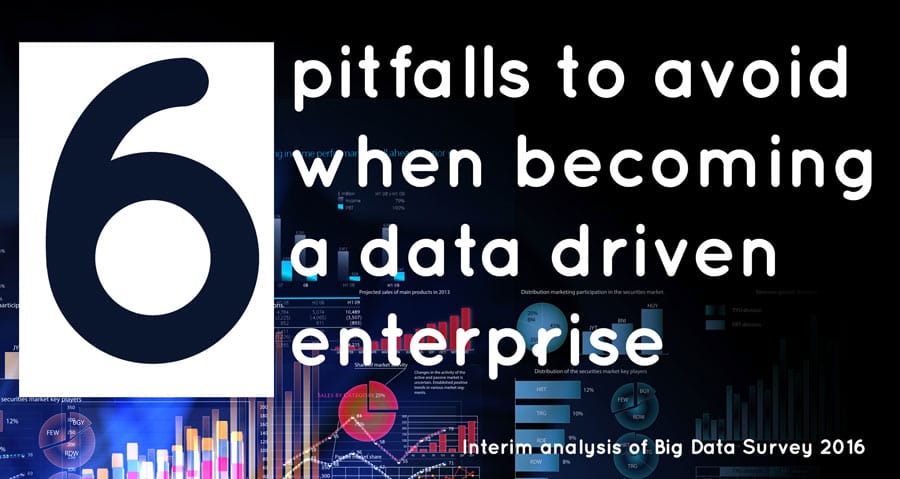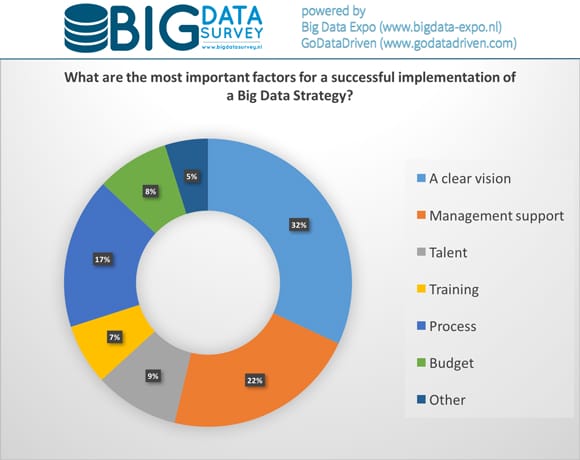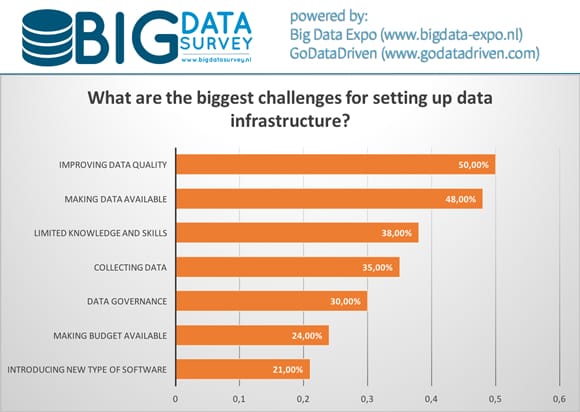
Now that Big Data Survey, the research on the application of data is midway through, it is time for an interim analysis of the score on the door. In this article we share six common pitfalls that organizations experience on their journey towards becoming a DataDriven enterprise.
1: Lack of Vision
Data Scientists can kick-start DataDriven innovation, but it’s the management that ultimately makes it a success. Just like last year, the initial results of Big Data Survey point out that data is definitely still a large theme for organizations. No less then 88 per cent of respondents indicate that the opportunities of data for their organizations are substantial. Remarkably, respondents also select of a strong vision (87%) and support from management (60%) as most crucial for success with data. So if you are a manager facing a team of enthusiastic data scientists, telling about successful experiments they have been running, remember that the next best action lies in your hands.

2: Lack of Data or Poor Data Quality
Data, we need more data! When it comes to laying the technological foundation, the data infrastructure, the biggest challenge is making data available (49%) followed by improving data quality (48%). We see that especially user generated data, as opposed to machine generated data, often is of poor quality. A strong ETL process is vital to get the right data in the system and so you can be confident of the outcome of machine learning models. We know you can do it, because the survey cleary indicates that developing the right skills to setting up data infrastructure (35%) seems to be less of a challenge.
Do organizations have a central data storage available? With 55% of participants indicating that their organizations have a central data warehouse, there is room left for improvement.

3: Perceiving cloud storage as not secure
Take me to the cloud! With more and more applications finding their way to the cloud, we were interested to learn what professionals think of the security of cloud storage. Remarkably, 1 in every 5 (22%) participants do not feel that data in the cloud is as secure as data stored locally. Also, 30% of the participants indicate that data within the organization today is not stored completely secure. If on-premises is really a safer place for your valuable data or not is not the question, as it’s the perception of the users that determines the adoption.
4: No room for experimenting
Being a DataDriven organization is not only about data and technology. If that was the case, becoming DataDriven would be easy. The supporting systems and processes are crucial as well, according to 46% of the participants. Room for experiments and an agile approach are vital ingredients for a successful DataDriven process. Multi-disciplinary teams are composed of members of different backgrounds, for example technical know-how and specific domain knowledge. Are organizations able to align their business and IT departments?
In Big Data Survey, we asked if IT & Business should work together to facilitate successful product innovation. Definitely, was the clear answer. 67% of the respondents agree totally with this statement, while an additional 22% partially agree.
Besides data, technology, and process, being data driven for a large part is also about the right knowledge and skills. Although 65% of the participants indicate that building up the know-how to set up the data infrastructure is not the biggest challenge, this is the other way around for building up Data Science skills. Over 55% of the participants experience the development of the right skills as the largest challenge while introducing a data driven process. While running experiments is essential for innovation, 44% of participants see that making time available to experiment is difficult within their organization. Working in multi-disciplinary teams is also not a given, with 36% of organizations having challenges with this way of working.
Still, 70% of respondents indicate that within their organization there is a reasonable amount of space to experiment. In the last stretch of Big Data Survey we hope to find out if this is really the case.

5: A non-personalized online user experience
Hello stranger, I don’t know who you are, but this is probably interesting for you…. Looking at the solutions that organizations develop, we see an interesting development. The number of organizations that develop predictive models (65%) is getting closer to the number of organizations that make use of dashboards and business intelligence (80%).
Despite the fact that marketing is the most popular application of data science, only 12.6% of researched websites is actually personalized in real-time. Most websites today are still static (50%), providing a poor and outdated user experience.
6: Inability to attract data professionals
Besides the aforementioned data, technology, process and skills, it’s the people that really make the difference. Not every organization employs data professionals, over 54% of organizations say they work with external consultants.
Organizations that recruit their own data professionals need to adjust their organization and working condition to the demands of data engineers and data scientists. A company car or a short commute are no crucial factors to select an employer. What matters most are the room to experiment, a transparent organization and above all: the knowledge level of colleagues that make the difference. Skills attracts skills.
Share your experience!
This article is an interim analysis of Big Data Survey. The full report will be available for all participants on September 21st. After participation in Big Data Survey you will receive an email as soon as the report is available. Hundreds of organizations from a wide variety have already shared their insights. Around 55 per cent of the participants work at organizations of over 100 employees and are a representative cross-section of the data population: 14% is BI Specialist, 11% Director, 10% Marketing Manager and 6% Data Scientist. It’s not too late to participate in Big Data Survey and receive the full research report. It takes only five minutes and provides an invaluable contribution to the insights from the survey.





